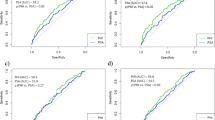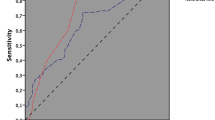Abstract
Objectives: Curative therapy and extendedperiod of disease free survival for patientswith prostate cancer is possible only if theradical prostatectomy is performed when thedisease is organ confined. It has been shownthat combined use of local clinical stage,Gleason score of transrectal needle biopsy andserum PSA can accurately predict the finalpathological stage in men undergoing radicalprostatectomy. Recently the free/total PSA (F/TPSA) has been shown to improve the specificityof serum PSA level in early detection prostatecancer. In this study the utility of F/T PSAratio in prediction the final pathologicalfeatures of the prostate cancer was investigated.Methods: 52 patients who had undergoneradical prostatectomy were included in thisstudy with mean age of 63 (ranging from 49 to73). According to the pathologic features ofthe tumors, patients were classified as organconfined in 37 (%71), specimen-confined in 39(%75) and as with favorable pathology whichwas defined as organ confined or specimenconfined with Gleason score lower than 7, 39(%75) patients.Results: Neither total PSA levels nor F/TPSA values correlate significantly with thepathological characteristics of the tumor. Thelogistic regression analysis showed that thebiopsy Gleason score was the only variable thatwas able to predict the pathology of the tumor(p < 0,05).Conclusion: As a conclusion Gleasonscore of the needle biopsy specimen is the mostpredictive factor of the final pathologicaloutcome. F/T PSA ratio did not provideadditional information about predictingpathological stage.
Similar content being viewed by others
References
Ackerman DA, Barry JM, Wicklend RA et al. Analysis risk factors associated with prostate cancer extension to the surgical margin and pelvic lymph node metastasis at radical prostatectomy. J Urol 1993; 150: 1845–1850.
Arcengeli CG, Shepherd l, Smith DS et al. Correlation of percent free PSA with pathologic features of prostatic carcinoma. J Urol 1996; 155: 420A.
Blackwell KL, Bosstwick DG, Myers RP et al. Combining prostate specific antigen with cancer and gland volume to predict more reably pathological stage: The influence of prostate specific antigen density. J Urol 1994; 151: 1565–1570.
Blustein DL, Bostwick DG, Bergralh EJ, Oesterling JE. Eliminating the need for bilateral pelvic lymphadenectomy in select patients with prostate cancer. J Urol 1994; 151: 1315–1320.
Bostwick DG, Quin J, Bergstralh E et al. Prediction of capsular perforation and seminal vesicul invasion in prostate cancer. J Urol 1996; 155: 1361–1367.
Fırat D, Hayran M. Cancer Statistics in Turkey and in the world (1990-1992). 1rd edition. Turkish Association for Cancer Research and Control 1995: 16–41.
Graefen M, Hammerer P, Henke P et al. Percentage of free PSA does not correlate with pathological outcome. J Urol 1996; 155: 237A.
Henricks WH, England BG, Donald A et al. Free to total PSA ratio does not predict extraprostatic spread of prostatic adenocarcinoma. J Urol 1996; 155: 236a.
Morete J, Encabo MA, Lopez MA, De Torres IM. The free to total serum prostatic specific antigen ratio as a predictor of the pathological features of prostate cancer. BJU Int 1999; 83: 1003–1006.
Narayan P, Fournier G, Gajandren V et al. Utility of preoperative serum prostate specific antigen concentration and biopsy Gleason score in predicting risk of pelvic lymph node metastases in prostate cancer. Urology 1994; 44: 519–524.
Oesterling JE, Brendler CB, Epstein JI et al. Correlation of clinical stage clinical stage, serum prostatic acid phosphatase and preoperative Gleason grade with pathological stage in 275 patients with clinically localized adenocarcinoma of the prostate. J Urol 1987; 92: 138–142.
Pannek J, Rittenhouse HG, Chan DW et al. The use of percent free prostatic specific antigen for staging clinically localized prostate cancer. J Urol 1998; 159: 1238–1242.
Partin AW, Yoo J, Carter HB et al. The use of prostate specific antigen, clinical stage and Gleason score to predict pathological stage in men with localized prostate cancer. J Urol 1993; 150: 110–114.
Partin AW, Catalona WJ, Sothwick PC et al. Analysis of percent free prostate-specific antigen (PSA) for prostate cancer detection: Influence of total PSA, prostate volume, and age. Urology 1996; 48(6A): 55–61.
Partin AW, Kattan MW, Subong ENP et al. Combination of prostate specific antigen, clinical stage and Gleason score to predict pathological stage of localized prostate cancer. JAMA 1997; 277: 1445–1451.
Sands ME, Zagars GK, Pollack A, von Eschenbach AC. Serum prostate specific antigen, clinical stage pathological stage and the incidence of nodal metastases in prostate cancer. Urology 1994; 44: 215–220.
Southwick P, Catalona WJ, Partin AW. Prediction of postradical prostatectomy pathological outcome for stage T1c prostate cancer with percent free prostate specific antigen: A prospective multicenter clinical trial. J Urol 1999; 162: 1346–1351.
Author information
Authors and Affiliations
Corresponding author
Rights and permissions
About this article
Cite this article
Erdem, E., Atsü, N., Akbal, C. et al. The free-to-total serum prostatic specific antigen ratio as a predictor of the pathological features of prostate cancer. Int Urol Nephrol 34, 519–523 (2002). https://doi.org/10.1023/A:1025685718493
Issue Date:
DOI: https://doi.org/10.1023/A:1025685718493




